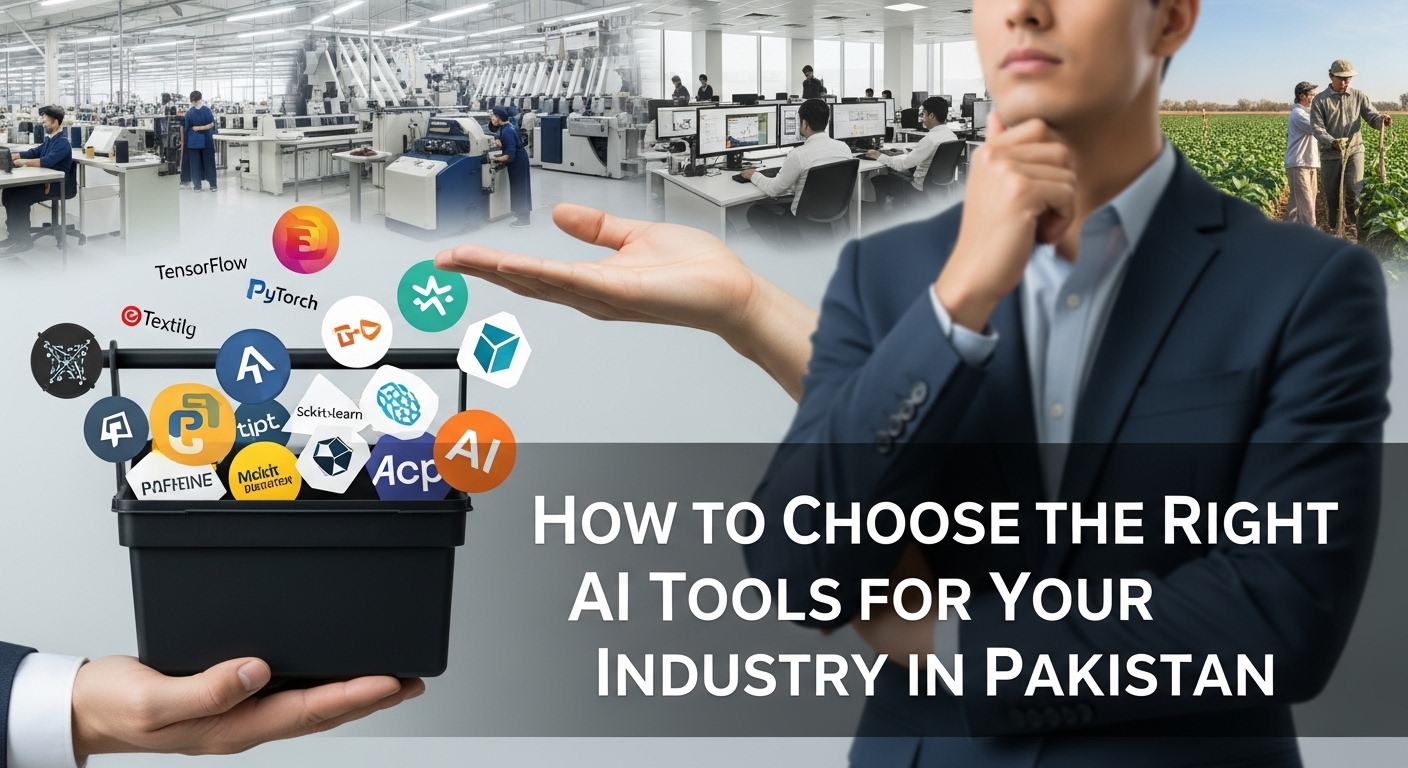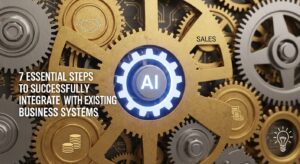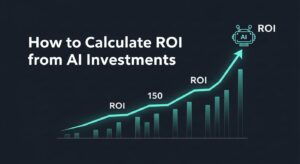Choosing the right AI tools for your industry in Pakistan has become a critical decision that can determine your business success in today’s competitive landscape. With artificial intelligence transforming industries worldwide, Pakistani businesses face unique opportunities and challenges when selecting AI solutions that align with their specific needs, budget constraints, and local market conditions.
Understanding AI Tools in the Pakistani Business Context
Before diving into the selection process, it’s essential to understand what constitutes an AI tool and how these technologies are being adopted across Pakistani industries. AI tools encompass a broad range of software solutions powered by machine learning, natural language processing, computer vision, and predictive analytics.
Pakistani businesses are increasingly recognizing that choosing the right AI tools isn’t just about following global trends—it requires careful consideration of local factors such as infrastructure limitations, regulatory requirements, and cultural nuances that affect technology adoption.
Step 1: Assess Your Industry-Specific Requirements
Manufacturing Sector in Pakistan
Pakistani manufacturing companies need AI tools that address specific challenges like supply chain optimization, quality control, and energy efficiency. When evaluating AI solutions, consider tools that can:
- Monitor production line efficiency in real-time
- Predict equipment maintenance needs to reduce downtime
- Optimize resource allocation based on demand patterns
- Ensure quality control through computer vision systems
Healthcare Industry Considerations
The healthcare sector in Pakistan faces unique challenges that AI tools can address. Key areas where choosing the right AI tools becomes crucial include:
- Diagnostic imaging analysis for remote areas with limited specialist access
- Patient management systems that handle Urdu and English languages
- Telemedicine platforms optimized for Pakistan’s internet infrastructure
- Electronic health records that comply with local privacy regulations
Financial Services and Banking
Pakistani financial institutions must choose AI tools that navigate strict regulatory requirements while improving customer service. Priority areas include:
- Fraud detection systems adapted to local transaction patterns
- Credit scoring models that consider Pakistan’s economic conditions
- Customer service chatbots supporting multiple regional languages
- Risk assessment tools for Islamic banking products
Step 2: Evaluate Technical Infrastructure Requirements
Internet Connectivity Considerations
Pakistan’s internet infrastructure varies significantly between urban and rural areas. When choosing AI tools, evaluate:
Bandwidth Requirements
- Cloud-based AI tools requiring consistent high-speed internet
- Edge computing solutions for areas with limited connectivity
- Offline capabilities for critical business functions
Data Storage and Processing
- Local data centers versus international cloud services
- Compliance with Pakistan’s data localization requirements
- Backup systems for unreliable power supply scenarios
Hardware Compatibility
Pakistani businesses often operate with mixed hardware environments. Ensure your chosen AI tools are compatible with:
- Legacy systems commonly found in Pakistani enterprises
- Mobile-first approaches given Pakistan’s high smartphone adoption
- Scalable solutions that can grow with your business
Step 3: Budget Planning for AI Implementation
Cost Structure Analysis
Understanding the total cost of ownership is crucial when choosing AI tools for Pakistani businesses. Consider these factors:
Initial Investment Costs
- Software licensing fees (often in foreign currency)
- Hardware upgrades or new equipment requirements
- Implementation and integration costs
- Staff training and development expenses
Ongoing Operational Costs
- Monthly or annual subscription fees
- Data storage and processing costs
- Maintenance and support services
- Continuous training and updates
ROI Calculation Framework
Develop a clear framework for measuring return on investment:
- Productivity Gains: Quantify time saved and efficiency improvements
- Cost Reduction: Calculate savings from automation and optimization
- Revenue Growth: Measure new opportunities created by AI capabilities
- Risk Mitigation: Value the reduction in operational risks
Step 4: Vendor Evaluation and Selection Process
Local vs. International Vendors
Pakistani businesses must weigh the benefits of local versus international AI tool providers:
Local Vendors Advantages:
- Better understanding of Pakistani market conditions
- Local language support and cultural sensitivity
- Easier communication and time zone alignment
- Compliance with local regulations and standards
International Vendors Advantages:
- Advanced technology and broader feature sets
- Proven track record in global markets
- Extensive research and development resources
- Comprehensive support documentation and communities
Key Vendor Evaluation Criteria
When choosing AI tools, evaluate vendors based on:
- Technical Capabilities: Does the tool meet your specific industry requirements?
- Scalability: Can the solution grow with your business expansion?
- Support Quality: What level of technical support is provided?
- Security Standards: Are international security protocols followed?
- Integration Capabilities: How easily does it connect with existing systems?
Step 5: Industry-Specific AI Tool Categories
Customer Relationship Management (CRM) AI
Pakistani businesses across industries benefit from AI-powered CRM tools that offer:
- Predictive customer behavior analysis
- Automated lead scoring and qualification
- Personalized marketing campaign optimization
- Customer service automation with multilingual support
Recommended Tools for Pakistani Businesses:
- Salesforce Einstein for enterprise-level solutions
- HubSpot AI for small to medium businesses
- Local alternatives like TechNinja CRM for region-specific features
Data Analytics and Business Intelligence
Choosing the right AI tools for data analysis helps Pakistani companies make informed decisions:
- Market trend analysis using local and international data sources
- Financial forecasting considering Pakistan’s economic indicators
- Supply chain optimization for import-dependent businesses
- Customer segmentation based on regional preferences
Process Automation Tools
Pakistani businesses can significantly improve efficiency by choosing AI tools for automation:
Robotic Process Automation (RPA)
- Document processing for government compliance
- Invoice and payment processing automation
- Inventory management optimization
- HR processes like payroll and attendance tracking
Step 6: Implementation Strategy and Change Management
Phased Implementation Approach
Successfully choosing and implementing AI tools requires a structured approach:
Phase 1: Pilot Testing (2-3 months)
- Select one department or process for initial testing
- Train a small group of power users
- Measure performance against baseline metrics
- Gather feedback and identify improvement areas
Phase 2: Gradual Rollout (6-12 months)
- Expand to additional departments based on pilot results
- Provide comprehensive staff training programs
- Establish standard operating procedures
- Monitor performance and adjust as needed
Phase 3: Full Integration (12-18 months)
- Integrate AI tools across all relevant business processes
- Optimize workflows based on accumulated experience
- Develop internal expertise and support capabilities
- Plan for future upgrades and expansions
Staff Training and Development
Choosing the right AI tools is only half the battle; ensuring your team can effectively use them is equally important:
- Develop training programs tailored to different skill levels
- Partner with local universities for ongoing education
- Create internal documentation in local languages
- Establish mentorship programs for knowledge transfer
Step 7: Measuring Success and Continuous Improvement
Key Performance Indicators (KPIs)
Establish clear metrics to evaluate the success of your AI tool selection:
Operational Efficiency Metrics
- Process completion time reduction
- Error rate improvements
- Resource utilization optimization
- Customer satisfaction scores
Financial Performance Indicators
- Cost savings achieved through automation
- Revenue growth attributed to AI capabilities
- Return on investment calculations
- Total cost of ownership analysis
Continuous Monitoring and Optimization
The process of choosing AI tools doesn’t end with implementation. Establish ongoing evaluation processes:
- Regular Performance Reviews: Monthly assessments of AI tool performance
- User Feedback Collection: Gather input from staff using the tools daily
- Technology Updates: Stay informed about new features and capabilities
- Competitive Analysis: Monitor how competitors are using AI tools
Industry Success Stories in Pakistan
E-commerce Sector
Pakistani e-commerce companies like Daraz have successfully implemented AI tools for:
- Personalized product recommendations
- Dynamic pricing optimization
- Fraud detection and prevention
- Supply chain management
Telecommunications
Major telecom operators in Pakistan use AI tools for:
- Network optimization and maintenance
- Customer service automation
- Predictive analytics for service planning
- Revenue assurance and fraud prevention
Banking and Finance
Leading Pakistani banks have chosen AI tools for:
- Credit risk assessment
- Anti-money laundering detection
- Customer service chatbots
- Investment advisory services
Common Pitfalls to Avoid When Choosing AI Tools
Over-Engineering Solutions
Many Pakistani businesses make the mistake of choosing overly complex AI tools that exceed their actual needs. Consider:
- Start with simpler solutions and scale up gradually
- Focus on solving specific problems rather than implementing comprehensive suites
- Ensure the chosen tools align with your team’s technical capabilities
- Balance feature richness with ease of use
Ignoring Local Factors
International AI tools may not account for Pakistani market conditions:
- Language requirements (Urdu, regional languages)
- Cultural considerations in customer interactions
- Local business practices and workflows
- Regulatory compliance requirements
Inadequate Change Management
Choosing the right AI tools without proper change management leads to poor adoption:
- Involve end-users in the selection process
- Communicate benefits clearly to all stakeholders
- Provide adequate training and support
- Address resistance to change proactively
Future Trends in AI Tools for Pakistani Industries
Emerging Technologies
Stay informed about upcoming AI developments that may impact your industry:
- Edge AI for improved performance in areas with limited connectivity
- Natural language processing in local languages
- Industry-specific AI solutions designed for Pakistani markets
- Integration with government digital initiatives
Government Initiatives
Pakistan’s government is actively promoting AI adoption through various programs:
- National AI Policy guidelines and support
- Tax incentives for technology adoption
- Digital Pakistan Vision initiatives
- Public-private partnerships for AI development
Conclusion
Choosing the right AI tools for your industry in Pakistan requires careful consideration of technical requirements, budget constraints, vendor capabilities, and implementation strategies. Success depends on taking a systematic approach that accounts for local market conditions while leveraging global best practices.
The key to successful AI tool selection lies in starting with clear objectives, thoroughly evaluating options, and maintaining a long-term perspective on technology adoption. Pakistani businesses that invest time in proper AI tool selection and implementation will be well-positioned to compete effectively in an increasingly digital marketplace.
Remember that choosing AI tools is not a one-time decision but an ongoing process of evaluation, optimization, and adaptation. Stay informed about technological developments, maintain close relationships with your vendors, and continuously measure the impact of your AI investments on business performance.
By following these seven essential steps, Pakistani businesses across all industries can make informed decisions about AI tool selection and implementation, ultimately driving growth and competitiveness in their respective markets.











